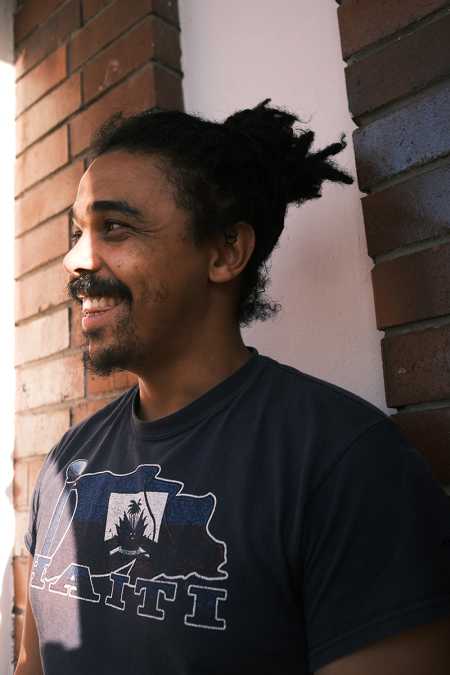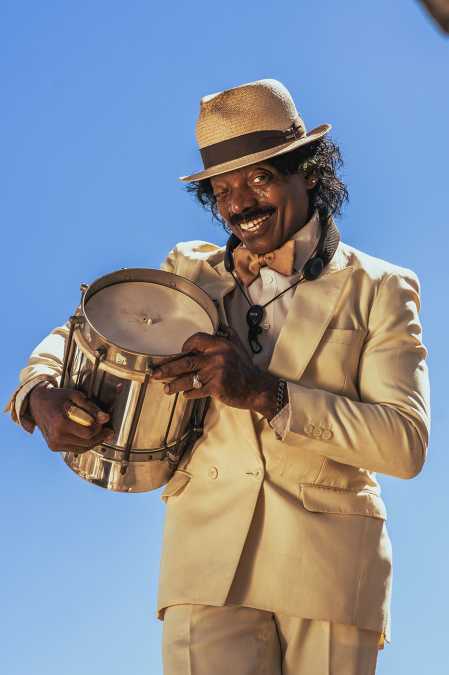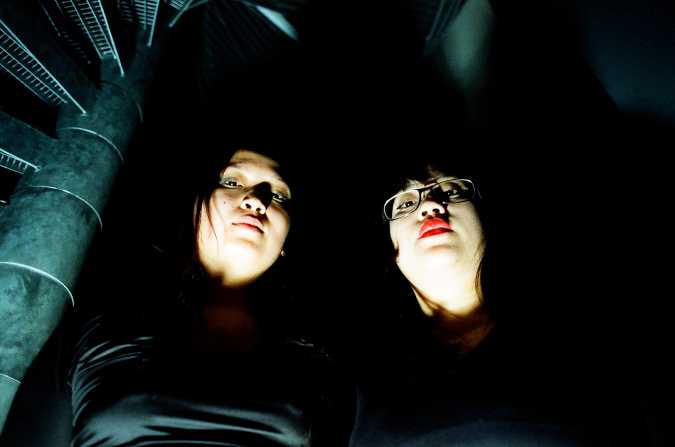Before debuting his immersive multimedia-performance Somnium at this year’s Le Guess Who?, we had an extensive chat with Dutch musician, songwriter, and composer Jacco Gardner. About Dutch explorers, silent film soundtracks, Zambian rock legends, strange peninsula’s and of course, his upcoming LP Somnium.
Jacco Gardner, sitting in the office space of Amsterdam-based label Excelsior, keeps insisting that everything he does is happenstance. Be it the powers of the universe, or the machines of God: for some reason, life keeps giving Gardner these strange signs, signs that indicate there could be some sort of grand design to it all. Of course, he can’t even begin to explain it, but given the fact that his girlfriend and fellow collaborator María Pandiello is a tarot card reader and has a PhD. in medievalist manuscripts and iconography, the thought surely must entertain him on a daily basis. "Mysteriously, the things I feel connected to just find their way onto my path."
Gardner has been remarkably busy in the three years since his second album Hypnophobia, jumping from rabbit hole to rabbit hole like the inquisitive spirit he is. You can take the whole ‘rabbit hole’ part quite literally for one particular project he participated in. At Portugal’s Tremor festival, to be precise, which is held at the far-out Atlantic peninsula of San Miguel. “I composed two experimental tracks for two forty minute walks through the vegetation there, which happens to be very strange, because these types of islands have a microclimate.” As you would expect, what Gardner encountered here was anything but ordinary.

“My walk started in meadowlands that actually seemed very Dutch, though a bit more hilly, with cows grazing on it. That’s where it started, but while walking through a little path, an Alice in Wonderland-like structure with an old gateway, you had to go down this very dark tunnel. As you emerge out of it, you end up in this thick intoxicated jungle.” One would imagine a scenery similar to the one on the luscious, chimeric album cover of Gardner’s debut LP Cabinet Of Curiosities. Gardner simply gives an affirming nod to this assessment. “It was the most otherworldly place I have ever seen. I walked around there on my own and I lost my way. I’ll never forget that feeling, being lost in a place that felt like it caught me. Like I was a prisoner of that place, and it was so astonishing, and I had to translate these feelings into the two compositions.”
Suffice to say, Jacco Gardner has been pondering a lot about the plethora of ways music can alter our daily realities. With his friend and bandmate Nic Mauskovic – leader of the sublime Mauskovic Dance Band –, he started an electronic project by the name of Bruxas. One primary objective was to move beyond the rigid hierarchy of band performances, something Gardner himself has grown quite bored with after years of non-stop touring. The two musicians, holed up in a countryside house in Portugal, experimented with two specific, equally hypnotic elements: weird, psychedelic sounds and the pulse of club music. What they have in common: they are about triggering the subconsciousness. “None of the tracks we recorded at the house ended up being part of the Bruxas project, but the idea of being able to play this type of music in clubs was worth investigating. In types of settings where people were not just staring at the stage with a beer in their hand, waiting to be entertained.”
Somnium
Which brings us to Somnium, Jacco Gardner’s upcoming album, to be released on November 23rd via Excelsior, Full Time Hobby and Polyvinyl. Suffice to say, even under his own name, Gardner has composed a sequence of music that burrows a little deeper in the consciousness than the supposed ‘retro’ pop melodicism that marked his previous work. That being said, Gardner insists Somnium isn’t all that great of a departure from Hypnophobia as one would think. A strange intermediate state triggered the latter album, one between consciousness and sleep, and symptomatically, it absolves into purely instrumental music. Which is pretty much the entire gist of Somnium: to eradicate voice and lyrics from the narrative. It’s a continuation, not a radical departure.
According to Gardner, the album’s more catchy moments serve as a foundation for the atmospherics, instead of vice versa. “The music accumulates naturally within the subconsciousness, where everything fits together in this very personal way,” he explains, “a place where even words don’t fit. Words are very binary. It’s challenging to describe it. So when journalists ask me deterministic, ‘What was the point of this, where did this come from?’, the moment eludes me. I just can’t tell.” Somnium is named after the novel written in 1608 by German inventor Johannes Kepler, and as Carl Sagan (who Gardner also references on Pale Blue Dot) once proclaimed, its regarded by many as the world’s very first science fiction novel.
A short documentary on the creative process of Jacco Gardner's third album "Somnium" by Portuguese director and sound recorder Miguel M. Cabral.
Though Gardner’s work does evoke a similar type of starry-eyed wanderlust of the Golden Years of Dutch innovation in the 1600s, he once again stresses that absolutely nothing about the Somnium project was premeditated. It eventually became something that was revealed to him in this very organic way. It all started very unassumingly: Gardner wanted to experiment more with vintage synthesizers, so before he moved to Lisbon, he set up shop in Pandiello’s workplace. The first ideas materialized there. “You know the saying of the sculptor who sculpts away, only to reveal what’s inside the slab of rock? For me it was very much like that, I considered those synths my pieces of stone I was chiseling away at, to see what’s hidden beneath.”
Once he settled in Lisbon, however, that creative spark escalated into quite the wildfire. The whole cityscape is the exact antithesis of your average Dutch town. Like any big city, it’s bustling with people, but its strange sloping hillsides allow you to see the depths of the landscape even from the heart. Depending on your vantage point, reality could change on a whim. “I wrote all the music for Somnium in one long session. All the transitions were done in that very same session. So in other words, I had to listen to it from beginning to end. Working like that, I very often exported it and listened to it while walking around the city.”
Gardner walked almost every day to pick up Pandiello from work, and the listening behavior it triggered was formative in shaping the album. “But the idea of walking through the city, or experiencing music while watching a movie, is that you’re always faced with new information. This new sensory input, even with smells, if you get that while you’re receiving new sounds, this combination can increase, or change your experience significantly.”
The W.I.T.C.H.
If first impressions are anything to go by, Somnium is Gardner’s equivalent to Bo Hansson’s fictional Lord Of The Rings album. Though he admits that’s one of his favorite records of all time, he didn’t set out to record ‘the imaginary missing soundtrack’ to Kepler’s long-lost novel. Composing a soundtrack, however, has always been a lifelong dream of Gardner’s. After all, he studied years and years for it. He finally got the chance in March 2017 in France, to compose a live soundtrack to Friedrich Wilhelm Murnau’s 1926 silent horror film Faust.
Though La Cinématheque, who commissioned the event, instructed an improvisational piece, Gardner just couldn’t bring himself to wing it. He wanted to treat the source material with some respect. “It seemed like a shame to just make noise. So I prepared a lot of things. So I formed an arrangement which I had to perform to an audience for two hours. It had to be all live. But there were only three people in attendance.” That didn’t matter the least to Gardner’s sense of fulfillment. “It was an amazing experience, I learned a lot from it. It was extraordinary to get the opportunity to do something like that.”

Gardner’s next soundtrack project will likely draw a bigger crowd. Director Gio Arlotta, a close friend of his, asked the musician to write a score for his upcoming documentary about Zambian rock legends the W.I.T.C.H.(We Intend To Cause Havoc). Enlisting Gardner was a logical next step, as he and Mauskovic have been performing with the reformed group for the past three years. There are only two official members of the W.I.T.C.H. left who haven’t succumbed to the AIDS epidemic: the first is Emmanuel ‘Jagari’ Chanda, the firebrand frontman who marked the band’s early 70s Zamrock era. The other being keyboard player Patrick Chisembele, who helped forge the W.I.T.C.H.’s more disco-oriented sound from the 80s.
“The documentary explains the backstory of the W.I.T.C.H., and of the Zamrock movement as a whole. The context of how that type of music came to be, the country, the developments it was going through at the time. It’s like a historical document. We used a lot of footage that Gio found in the archives, but aside from that, it shows the dream of Jagari, the leader of the band, to travel to Europe to play the music again. He has had a very dynamic life – he is considered the Mick Jagger of Zambia, he was a crazy performer, and the band sold out entire arenas in Zambia back in the day. He went from that to not playing music anymore. He had been told to burn all his records because it conflicted with his newborn Christianity. His wife is a priest.”
Amazingly enough, Gardner and Mauskovic’s recruitment happened during Le Guess Who? 2015, when Gardner curated his own line-up (aptly named Cabinet Of Curiosities). Here, Arlotta organized live sessions with artists like Michael Rault, Dungen and Eerie Wanda. At the time, Mauskovic and Gardner were already toying with the idea to explore the continent of Africa. As fate would have it, Arlotta was looking for potential session players to reform the W.I.T.C.H.. In other words, this was a no-brainer, one that resulted in shows in both Jagari’s hometown of Lusaka, Europe and more recently, South Africa. Though it was at times tricky to grasp strongly improvisational nature of the W.I.T.C.H.’s bass lines, the experience reaped nothing but rewards and good memories for Gardner.
“To meet people there with such a strong connection to the music, especially in Zambia, and their fascination for Western music like Black Sabbath and The Rolling Stones, it’s all very alive there. But on the other side, they fuse that with Zambia’s own extensive musical heritage. The music Nic and I listened to at the time was in many ways connected more to their heritage. But of course we have our the Western rock aspect, which is part of us anyway, The Beatles and Stones are part of our heritage whether we want it or not.”
“So connecting with the people through the music of the W.I.T.C.H,” he continues, “and playing those songs, being able to build it together –because Zamrock represents both sides – it was one of the most magical things I have ever experienced.”
Volverium
Since Jacco Gardner’s previous collaboration with Le Guess Who? led to this crazy three-year adventure with the W.I.T.C.H., it’s anybody’s guess what kind of ripple effect his upcoming appearance will make. For now, he has had his fill of shows within a band-focused set-up, so he’s avidly pushing for a different type of sensory experience. With recent projects that involve film soundtracks to unorthodox compositions based on jungle walks, it’s clear Gardner doesn’t just want to explore the boundaries for himself but stimulate listeners to do the same. On the release date of Somnium, Gardner will perform Volverium with multimedia artist Thijs Biersteker at the Artis Planetarium, a surround sound experience that incorporates a comprehensive virtual reality installation.
“At first it was just going to be an installation, a music video experience live streaming with the entire album.” Gardner says. Upon witnessing the first blueprints for Biersteker’s VR-installation, however, Gardner immediately noticed parallels with the Dutch innovators of the 17th century, when people like Galileo (who was an expat at the time) and Christiaan Huygens marveled at the planets and solar systems, devising history-altering scientific theories of heliocentric distance and gravity.
“Yeah, and the alchemists of the Dutch innovation were developing lenses,” Gardner enthuses. “People like Christiaan Huygens, Cornelis Drebbel and Jacob Metius. For some reason, I saw that pioneering spirit in Thijs and his invention. It’s not something he outright pitched to me. It was just there already. Strangely enough, it fits extremely well, since the installation has these lenses revolving around us, using a cutting-edge type of stereoscopic camera. Which, when you talk about lenses, are all about changing your reality, expanding your reality, and peering into these extremely far distances or microscopic worlds. All those realities greatly expanded humankind's reality. It’s amazing how perfectly that’s linked to virtual reality. It’s almost like Thijs came up with this invention as one of those Dutch innovators, related to lenses, and I’m using that and putting it as much as possible in the spirit of Dutch innovation, as a conceptual and symbolic layer that’s part of both the album and the live performance.”
Indeed, though somewhat a case of life imitating art, virtual reality is still in that rudimentary eureka-phase; we are only now beginning to comprehend how virtual space can be utilized. It must have been a similar epiphany to Huygens when he discovered that each star had entire planetary systems revolving around them. But those scientific breakthroughs were just as much triggered by limitless imagination. The concept of Mars holding a populace of Renaissance-style aliens sounds more deliciously crackpot than what we know now: this lifeless rocky planet that maybe has some trace of microbes or hydrogen on its surface.
A playlist by Jacco Gardner with 'Somnium inspirations'
Gardner too is very enamored in the ways fantasy and reality can emancipate and enrich each other. Like with the Faust soundtrack, the idea of introducing a fictional reality to the performance was way too tempting not to investigate. “The show will have an introduction in which I’m adding a piece of fictional history where Johannes Kepler and Cornelis Drebbel have met,” Gardner outlines. “Many Dutch inventors at that time destroyed their blueprints and inventions when they died because they didn’t want someone else to take credit for them.” The petty competition between inventors was the one foil to push the human race further. “Just imagine the impact of the telescope, the microscope and the projector on our realities, and imagine there could have been more things invented. Which on one hand, is a shame. But on the other hand, incredible!”
Like his 17th Century forebears, Gardner started hypothesizing on his own. “I created this whole story arc which I’m adding to the live show, and Thijs’s installation plays a big part. The installation wasn’t intended to complement the story in any way. It functions as a live actor, as it perfectly executes the story I wrote. It just so happened to fit. It’s based on the time that Johannes Kepler worked for Rudolf II, who is the emperor of Bohemia. In a castle in Prague, Czech Republic Rudolf held court, and Kepler served there as his chief adviser. Funnily enough, Rudolf owned the biggest cabinet of curiosities in the world. I didn’t know about that, but as I was putting it all together, I stumbled on it. And of course, Cabinet Of Curiosities happens to be the title of my first album. So that spirit of that time came back full circle to the moment I started my career.”
It gets crazier, Gardner promises, rapturing increasingly like a walking, talking Expanding Brain Meme.“I also hypothesized that Cornelis Drebbel was invited by Rudolf to the court– because he was making such spectacular inventions – just to entertain the courtesans. Drebbel showed Rudolf this invention, supposedly called the Volverium. Here’s what I fit into this fictional history: Kepler got the dream he based Somnium on, because of an Oracle-like machine which evoked dreams, generous dreams. The thing is, as I read more and more about it, I found out that Cornelis Drebbel, Kepler and Emperor Rudolf had actually met in that court during the time Kepler wrote Somnium.”
In other words, Drebbel’s invention compelled Kepler, perhaps subconsciously, to write Somnium. Gardner: “It wasn’t a fictional history anymore, it was just history.”

So when Jacco Gardner will unveil Somnium for the first time at Le Guess Who? this weekend, who knows, maybe we will meet our little green men? The imagination can’t stretch far enough, as far as Gardner is concerned. “Maybe! How can you not? When you discover such a thing, are you going to stop your imagination? No! You have to go there! Just like the way Kepler imagined Somnium, they were observing us from their planet. All those visions that come up, why would you want to stop that? They are so beautiful. A lot of people would say, ‘That’s just silly fairy tales!’ It’s true, these innovators had scientific aspects and completely delusional aspects. And to them, those two things had to coexist. And the reason they made these discoveries, to begin with, was their inquisitive state of mind and character, in which magic and mystery significant enrich our reality. No one was there to tell them that it wasn’t. So in the end, what truly matters?”
This does bring up a cogent point, concerning the great unknowns that are portrayed in popular culture. Whether it’s A.I. or extraterrestrial beings, they don’t always have to reflect our inherent fears. Gardner often jokes of the many times he’s asked whether he was born in the wrong century. But by embracing that stubborn obliviousness and sense of wonder and engaging with things like VR technology, he realizes that the biggest what-ifs are often hidden beyond our very reach. Whether it’s in the past or the future, the point is to always venture beyond. Unfortunately, the time machine hasn’t been invented yet, but it’s not like that’s stopping Jacco Gardner.
“You never arrive at a destination, you’re always exploring. The adventure is endless. To feel like that in your daily life is natural, but at the same time also very rare. I think a lot of people feel like that. But then again, once people notice a difference in realities, they punish each other for those very differences. ‘No you’re wrong, this is the true reality.’ Generally speaking, people can be extremely cynical. But even the most cynical of people have dreams in which the strangest images come to them. And then they choose to hide it away again. They wake up in the morning, and they go to work. I always marveled at that, and I always want to be someone who introduces an invitation to do the opposite.”
If Jagari’s dream of performing with the W.I.T.C.H. again, Kepler’s dreams of our Earth-Moon and Gardner’s own dreams hold any validity, it’s that perhaps, our ability to dream can change reality itself.
Jacco Gardner premieres his multimedia-performance Volverium at Le Guess Who? 2018 on Friday, 9 November. Also performing at the festival are a.o. Neneh Cherry, Devendra Banhart, The Breeders, Colin Stetson, The Heliocentrics, Vashti Bunyan, Colin Stetson, Midori Takada, Deep Fried Grandeur with Ryley Walker & Kikagaku Moyo, and many more.
Interview by Jasper Willems.
Photography by María Pandiello.




